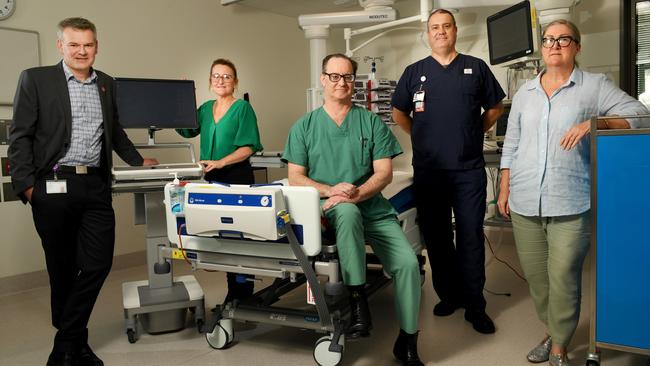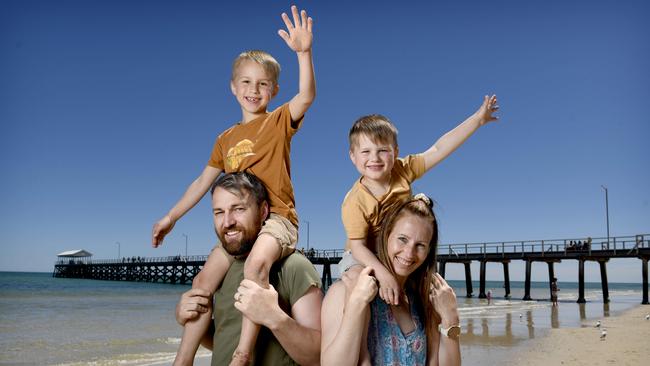Professor Nicola Spurrier releases modelling showing how many will end up in ICU and how many will die once borders open to SA
Before Omicron, SA's chances of an 'outbreak' when we reopened borders was 27 per cent, but now cases are exponentially rising. See the modelling – and how things have changed.
SA News
Don't miss out on the headlines from SA News. Followed categories will be added to My News.
In a time before Omicron, SA's Covid modelling showed there was just a 27 per cent chance of an outbreak – an average of more than 100 daily cases over any three-day period.
Today, the state recorded 64 cases – the highest number since the start of the pandemic. That number is predicted to continue to increase now borders have opened; it might not be long until we have an "outbreak" on our hands.
Chief public health officer Nicola Spurrier said on Friday that the rise of the Omicron variant had changed things.
"I do think it's reflecting what's happening in NSW and Victoria with increasing case numbers," she said.
"But at the end of the day, our sights are on hospitalisations and how sick people are getting."
Since borders opened on November 23, SA has had three admissions into hospital – and no one is yet to be put in the ICU or on a ventilator.
Take a look at the Delta modelling below, what SA was expecting in early November, and how Omicron has changed things.
DELTA MODELLING: WHAT SA WAS EXPECTING ON NOVEMBER 1, 2021
Modelling underpinning the imminent reopening of South Australian borders shows the health system can more than cope with hospital admissions and a predicted 13 deaths across almost a year.
The state’s chief public health officer, Professor Nicola Spurrier, outlined to The Advertiser a “manageable scenario with respect to hospital capacity” that predicts peak ward and intensive care occupancies of 36 and nine beds respectively.
For children aged up to 11 who have not yet been able to get vaccinated, the peak ward occupancy is seven beds and ICU occupancy is one.
The Doherty Institute modelling shows the chance of an outbreak – averaging more than 100 daily cases over any three-day period – is estimated at 27 per cent, indicating the effectiveness of 80 per cent-plus, double-dose vaccinations which is the trigger for reopening borders, expected on November 23.
The forecast fatalities and hospital admissions span a 300-day period, meaning fewer deaths would result from introducing Covid-19 at current restrictions than from influenza in a typical year.
Premier Steven Marshall said the threat of statewide lockdowns was in the past once the state reached the 80 per cent target.
“What people in South Australia wanted to know is when can we have that threat removed. The answer is November 23,” he said. “At the same time, we’ll remove the threat of whole-of-state lockouts. So we’re moving to a more targeted approach.”
Professor Spurrier said the modelling demonstrated the vaccines were “more effective than we ever dreamed of” and stressed it “really should be very comforting that these vaccines are more effective than the flu vaccines”.
“If you get infected as a fully vaccinated person, you are much less likely to go to hospital, you are much less likely to have any symptoms, you’re much less likely to pass it on to somebody,” she said.
Professor Spurrier notes the model assumes public health and social restrictions in place at the start of the border reopening remain for the 300-day period, indicating the continuation of some mask wearing, QR code check-ins and limited restrictions.
Professor Spurrier and Mr Marshall released the modelling, completed in conjunction with the University of Adelaide, that was considered by the state’s transition committee when signing off last Tuesday on the reopening road map.
“When the South Australian borders open at a level of 80 per cent vaccination of those over 16 years, maintaining current public health and social measures (activity restrictions), along with the testing and contact tracing capacity in South Australia will allow us to remain within the state’s hospital ward and ICU (intensive care unit) capacity,” Professor Spurrier’s summary says.


The modelling covered three scenarios: current restrictions; removing mask mandates in “general settings” and allowing higher-risk activities for fully inoculated people by introducing vaccine certificates.
The modelling also assessed the likelihood of demand exceeding 200 ward beds and 30 ICU beds, thus restricting services for other patients. This is considered an extremely small chance under current restrictions.
If the government had opted to open borders without general mask mandates, 55 deaths were forecast and peak ward and ICU occupancy of 70 and 18 beds respectively.
Allowing higher-risk activities for the fully vaccinated takes the chances of an outbreak to 84 per cent. It is forecast this would cause 315 deaths, along with peak ward and ICU occupancy of 351 and 72 beds respectively.
The modelling assumes someone with two Pfizer doses is 75 per cent less likely to become infected with Covid-19 and 83 per cent less likely to have symptoms. They are 91 per cent less likely to be admitted to hospital, require ICU admission or die.
Mr Marshall said it was too hard to tell when SA would hit the 90 per cent vaccination target for people aged 12 and over that would end major restrictions for hospitality venues and private gatherings.
Alana Harvey, 38, of Gawler South, said her family was looking forward to visiting relatives interstate. “Just having that freedom of not having to worry that the borders are going to be closing or having to quarantine when we come back from visiting is a relief.”

THE THREE SCENARIOS
Scenario 1: Maintaining current PHSM (ie, current restrictions)
Under this scenario, the model suggests that South Australia will be able to manage the ward and ICU demand from Covid-19 infections generated in the community.
The chance of an outbreak – that is averaging more than 100 cases per day over any three-day period – is estimated to be 27 per cent.
In the event of an outbreak, this scenario is estimated to be manageable with respect to hospital capacity:
■ Peak ward occupancy 36 beds (range 21, 78 [median, 95 per cent confidence interval]) and extremely small chance of demand exceeding 200 ward beds
■ Peak ICU occupancy 9 beds (range 5,19) and extremely small chance of demand exceeding 30 ICU beds
■ Total deaths (over the 300 days) 13 individuals (range 4, 51)
Peak ward occupancy and Peak ICU occupancy for those aged 0-11:
■ Peak ward occupancy (0-11 years) 7 beds (range 2, 21)
■ Peak ICU occupancy (0-11 years) 1 beds (range 0, 5)
Scenario 2: Relaxing restrictions from current PHSM – by removing mask mandates in general settings but keeping all other public health restrictions in place
The chance of an outbreak is estimated to be 64 per cent.
In the event of an outbreak, this scenario is estimated to present risks to being able to manage cases in particular with respect to ICU capacity:
■ Peak ward occupancy 70 beds (range 23, 203) – and a 3 per cent chance of demand exceeding 200 ward beds
■ Peak ICU occupancy 18 beds (range 6, 47) – and a 20 per cent chance of demand exceeding 30 ICU beds
■ Total deaths (over the 300 days) 55 individuals (range 6,186)
Scenario 3: Relaxing restrictions from current PHSM – by introducing the use of vaccine certificates (with 75 per cent compliance to this requirement) allowing higher-risk activities by fully-vaccinated individuals
The chance of an outbreak is estimated to be 84 per cent.
In the likely event of an outbreak, this scenario is estimated to present risks to being able to manage cases, in particular with respect to ward and ICU capacity:
■ Peak ward occupancy 351 beds (range: 24, 585) – and an 85 per cent chance of demand exceeding 200 ward beds
■ Peak ICU occupancy 72 beds (range: 6, 119) – and an 87 per cent chance of demand exceeding 30 ICU beds
■ Total Deaths 315 individuals (range: 8, 424)





